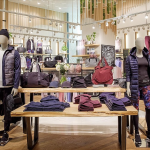Nike, Inc. rolled out its 23:11 strategy a year ago, outlining goals of reaching $23 billion in sales by the year 2011. Progress against that plan appears to be on track as the weaker U.S. dollar, successful inventory controls, gains in U.S. market share, and growth in the owned-retail business all combined to help the company deliver over $1 billion in free cash flow from operations over the first three quarters of fiscal 2008.
Revenues for both Nike, Inc. and the Nike brand grew nearly 16% for the companys fiscal third quarter ended February 29, with 6 points of growth from the weaker U.S. dollar. The company reported growth across all four regional businesses and subsidiaries, with only the equipment business in the U.S. posting a negative.
The Nike brand posted a 15.2% increase in footwear sales to $2.45 billion. Apparel sales were up 18.3% to $1.23 billion, while equipment sales jumped 10.7% to $255 million. The soccer business grew at a double-digit rate.
Sales at Nike owned-retail stores in the U.S. grew 13% for the quarter, with comp store sales increasing 3% for the period in both first quality and factory outlet stores. The company also saw “strong growth” in its online business. There were 331 factory outlet stores in operation at quarter-end, with 14 new stores added during the nine-month year-to-date period. Roughly half of the 331 stores are in the U.S.
The company revamped and enhanced the running experience at its NikeTown store in New York, which management said continues to “generate very solid results.” Revenue from that running experience is up 35% and it is also credited with driving store traffic up 14%.
Nike will take a similar approach at its London location, but focused on soccer. They will call it the Boot Room. They plan to have it up and running in time for the Euro Championships this summer.
The Brand Nike international business accounts for roughly 60% of brand revenues, growing roughly 24% from the year-ago period. International futures for the next five months grew at a mid-teens constant dollar rate.
In the EMEA region, which includes Europe, the Middle East and Africa, roughly 13 points of the 23.1% increase in sales came from shifts in currency. In currency-neutral terms, both footwear and equipment grew in double-digits and apparel increased 8% for the quarter.
Currency-neutral revenues for the emerging markets in the region were up 34% as every country in the group delivered double-digit revenue growth. The balance of the region reportedly grew at a mid-single-digit rate, driven by “strong growth in the U.K., Germany and northern Europe.” The Nike brand saw an 11% increase in revenue in the U.K., where the company has been cleaning up distribution and managing inventory and pricing. The sub-region of central European countries delivered double-digit revenue gains in every single country, led by Russia, Turkey and Poland.
The football (soccer) category was a key contributor, growing 10% on a constant dollar basis. Footwear and apparel increased in both revenue and margins to drive “very healthy profit growth.” Management said the growth “yielded market share gains in footwear and apparel in all of the big five Western European countries.”
Futures orders for the EMEA region grew 9% in constant dollars, “reflecting continued growth in nearly every country in the region.”
The Asia-Pacific region posted the highest growth rate of the regions, with currency exchange rate fluctuations contributing approximately seven points of the 26.9% increase in revenue for the fiscal third quarter. Currency-neutral footwear revenues increased 22%, apparel grew 19% and equipment improved 15% for the period.
While revenue increases were described as “broad based” across the region, the growth engine continues to be China. Revenues in China increased almost 50% on a currency-neutral basis for the quarter. The company had planned for Brand Nike sales to reach $1 billion in China by the end of this fiscal year, but management said the country had achieved that milestone for the trailing twelve-month period. Nike brand President Charlie Denson said the number wasnt a goal, but a starting point for future growth.
NKE said growth in China has been driven by new store openings and strong comp store sell-through driven by brand building investments around the Beijing Olympics and the “Just Do It” campaign. Nikes retail accounts opened almost 900 new doors in Q3, bringing the total number of stores to nearly 3,500 at period-end.
Japan revenues grew 4% on a currency-neutral basis. Management described the progress there as “steady” as they focus on the quality of business.
Asia-Pacific pre-tax income improvement was driven by strong revenue growth, expanding gross margins, SG&A timing and stronger currencies.
The Americas region also got a lift from the weaker U.S. dollar, with more than half of the 19.7% increase for the third quarter coming from currency fluctuations. Excluding the effects of currency, revenue in the region was driven by the Latin America markets, led by growth of over 15% in Argentina, Brazil and Mexico.
Pre-tax income for the Americas region was fueled by revenue growth, gross margin expansion and favorable exchange rates.
In the U.S., management said they saw “solid results,” which they said were “all the more remarkable given the uncertainties in the marketplace.” Revenues were driven by higher sales in nine out of ten top accounts. For the first time in a third quarter, U.S. footwear revenue surpassed $1 billion.
Growth in the U.S. footwear business was driven largely by a higher average price per pair as unit volume was basically flat. Gross margins expanded two full points. Management said most of the average selling price gain was driven by “surgical price increases” taken for the spring season and a shift in mix to higher-priced sportswear and away from kids products. Nike saw double-digit revenue increases in mens training, womens training and running.
U.S. apparel revenue was up overall but management said they could do better, specifically calling out sportswear as an issue. The company is cleaning out inventory in sportswear, moving a lot of it to the factory stores. The U.S. apparel business saw growth in performance categories such as running, mens training and womens training that was partially offset by softness in basketball products.
While management acknowledged that futures growth at period-end was softer than they have seen in several quarters, they said they feel pretty good about the quality of the business in the U.S., “successfully navigating the current environment with an eye towards long-term, healthy, sustainable growth.”
Third quarter pre-tax income for the U.S. was driven largely by revenue growth, expanding footwear margins and lower SG&A spending, driven largely by the timing of demand creation.
In the subsidiary and affiliates businesses, Converse delivered another big quarter as revenues increased 29% and pre-tax income grew 24%. Management said the Converse One Star product launch at over 1,600 Target Stores is generating numbers that are well above plan.
Hurley delivered its biggest quarter ever with revenues up 33%.
Revenues for Cole Haan and NIKE Bauer Hockey each grew double-digits. Cole Haan has been “very strong,” especially in the wholesale business and NKE sees a lot of potential with Cole Haan Sport, integrating a lot of Nike technology into that line.
NIKE Golf reportedly delivered another solid quarter, driven by growth in the U.S. and international markets.
Overall pre-tax income for the Other businesses increased 16%, driven by strong revenue growth and expanding gross margins, partially offset by higher operating overhead investments and infrastructure.
NKE completed its sale of the Starter brand to Iconix Brand Group, Inc. in December, resulting in a gain of $29 million which is included in Q3 Other Income.
For the fourth quarter Nike, Inc. is projecting low-double-digit revenue growth, driven by business momentum and the continued weakness of the U.S. dollar. For fiscal 2009, NKE is targeting high-single-digit revenue growth and continued EPS leverage.













